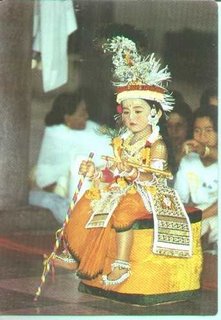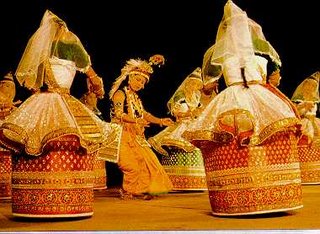
Wildlife - a rich natural heritage of Manipur:
Even though Manipur is a tiny state in the North Eastern Fringes of
India, she is exceedingly rich in natural resources with a vast and
varied fauna heritage. This region is included in the same Zoological
province as the forest region of the Himalayas with the same gradation
from tropical to temperate vegetation. The distribution and character of
animal life is also similar, but in addition distinctly Malayan type
fauna is traceable all through the province with an intermingling of
peculiar forms. This results in the diversity and peculiarity of the
Wildlife found in Manipur.
Problems and Prospects:
It is quite unfortunate that a large number of birds and animals have
become extinct in Manipur that too, in the recent past. The Javan
Rhinoceros was seen roaming along the Khuga river valley in
Churachandpur district as late as the beginning of 20th century, but now
it is extinct from Manipur and hence from India. The wild Ox of Myanmar
(Bantering) know as 'Santhou' in Manipuri was last seen thirty years
ago. In all probability these animals have vanished from the Manipur
soil forever. The Hoolock Gibbon, Stump Tailed macaques, Slow Loris,
Clouded Leopard, Golden Cat, Marbled Cat, Banturong, Spotted Linsang,
Malayan Sun Bear, Smooth Indian Otter, Hog Badger, Malayan Gaint
Squirrel, the Serow (Sabeng) and most other denizens of forest are
making a precarious existence in the forests of Manipur, and all of them
are on the verge of extinction.
Among the birds, the White Wood Duck, Pink Headed Duck, Grey-Leg Goose,
Mallard, Brahminy Duck, Clucking-teal, Plover, Hooded Crane, Brown
Headed gull, Avocat White ibis, Glossy Ibis, Indian Shag, Open Bill
stork, Black Necked Stork, and a host of others have become extremely
rare, and many of them are probably extinct from the State.

The reasons for the dwindling wildlife are not far to seek. An explosion
of human population with diverse and intense human activities have had
far reaching effects on Wildlife. Rapid deforestation resulting in
habitat destruction coupled with indiscriminate hunting of birds and
animals have threatened many species with extinction. In the hills,
where people pride themselves as traditional hunters, it would be a pity
soon enough if they are left with no animal to hunt at all. It needs to
be admitted that messages of conservation are yet to reach the interior
hills of Manipur, and even so, only the economic development of the
people would enable them to overcome the compulsion of over exploiting
the living natural resources of the State.
In order to prevent the destruction of Wildlife in the State, as early
as 1931, Captain CLW harvey, the then President of Manipur State Darbar
promulgated the Game Rules of Manipur. The Wildlife (Protection) Act,
1972 was introduced in Manipur State from the 15th May, 1973, thereby
offering legal protection to all forms of wildlife in the state. In
accordance with the advice of the Wildlife Advisory Board, the Manipur
Zoological Garden, Iroishenba, at the Western hill side of Imphal, was
established on 2 October 1976 where captive breeding of rare and endemic
species are being under taken. The Manipur Zoological Garden, as of
today, is the jewel box of rare animals some of which are found only in
this part of the country.
Information of the Wildlife of Manipur is incomplete without a specific
reference to the nominate species of the Elds' deer, locally known as
Sangai (Cervus Eldi Eldi, Mc. Clelland, 1842). Once believed to extinct,
this raremost cervid was rediscovered in the year 1953. The unique
habitat of this most threatened cervid in the world constitute mostly of
floating mats of vegetation (known locally as phum/phumdi) on Loktak
Lake. The habitat of this deer comprising of 40 sq.km. was declared as a
National Park in the year 1977. Though not a spectacular increase, the
population from about 14 heads in 1974, has grown to 147 individuals in
1997. In this fragile eco-system, this endemic deer still faces the
danger of extinction. All our efforts are being made by the Wildlife
Wing of the Forest Department with the active co-operation of local
people to save this race of deer.
The most deciduous forests of the Indo-Myanmar border areas sustain rare
flora and fauna. Of late, in one year, six species of plants new to
India and two species new to science were described from these forests
and there are still many more plants and animals yet to be identified
and named. An area of 184 sq. kms. of these for are given legal
protection of Wildlife Sanctuary and with proper management, there is
hope that these rich forests with their denizens could be preserved for
posterity. This could therefore be possible only with the active
co-operation of the local people.
The Shiroy Kasom hill range, the habitat of the endemic ground lily,
Siroy lilly (Lilium macklinease) and also the habitat of Mrs. Hume's
barredback pheasant and Blyth's tragopan are now proposed to be declared
as a National Park. The Keilam hill ranges that host extremely rare
species of animals particularly Horn Bills has been declared as a
Sanctuary. Similarly Zeliad lake also has been initially notified as a
Wildlife Sanctuary. It is hoped that they will be finally declared very
soon.
The Dzuko valley is yet another region presenting a rich multitude of
flora and fauna in Manipur. Some areas of this valley still remain
undisturbed by human activities and it is worth while to turn this vast
valley in a Biosphere Reserve so that its splendid genetic diversity
could be preserved for posterity.
Every year a 'Wild Life Week' is observed to highlight the importance
Wildlife Conservation and emphasize on the need to take immense steps
for the preservation of our natural resources. As a part of the
observation of the Week, essay writing competitions, painting, and
pencil sketch competitions are held for the students in the State. Film
shows on Wildlife would be screened at different places in all the seven
days of the week. Broadcasts on related topics from knowledgeable
persons are expected to bring about the problem and prospect of Wildlife
conservation in Manipur. The schools and colleges can generate a great
deal of interest in Wildlife topics by arranging meetings, debating
competitions, quiz programs, etc. Similarly, if all the non government
agencies which are active in the field of socio-economic development of
the state were to take up the cause of wildlife much could be achieved.
The Forest Department would once again appeal to one and all to
contribute whole-heartedly in the noble task of conservation of
Wildlife. ?Grow Trees for Prosperity, Preserve Forest and Wildlife'.
Wildlife Sanctuaries:
A. Protected Area network in Manipur:
1. Keibul Lamjao National Park 40 sq. km.
2. Yangoupokpi Lakchao Wildlife Sanctuary 184.8 sq. km.
3. Orchid Preservation Plot 0.5 sq. km.
4. Second home of Sangai (Iroisenba) 0.6 sq. km.
B. Protected Areas initially declared as Wildlife Sanctuary:
1. Keilam Wildlife Sanctuary 187.5 sq. km.
2. Zeliad Wildlife Sanctuary 21.0 sq. km.














